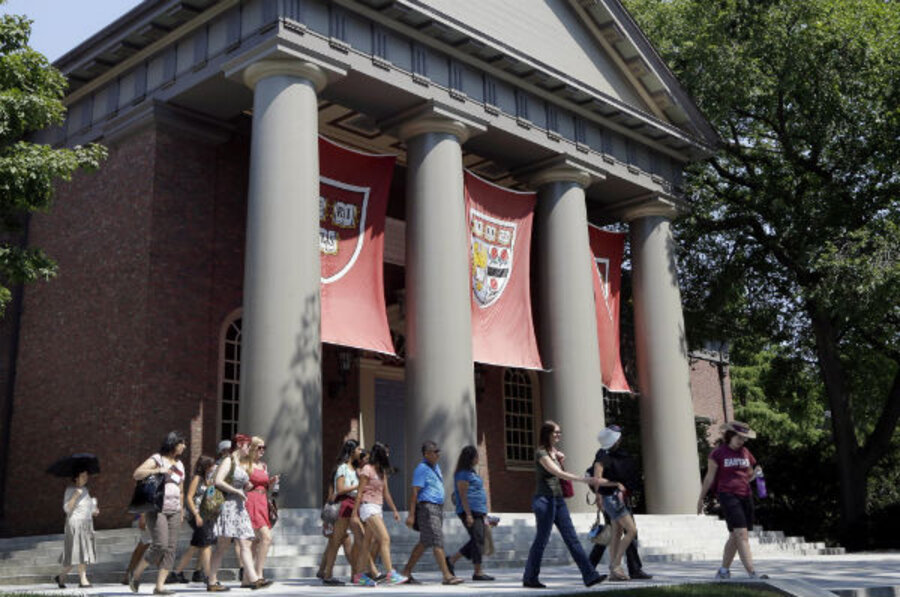College costs: High-sticker-price schools may cost less in the end
Loading...
Don't let the big price tags nix an application to Harvard or Yale. The average student receiving financial aid on those campuses paid about a quarter of the public sticker price and most graduates leave their ivy-covered quads with smaller debts than peers who attended less prestigious schools.
It's not that unusual, according to statistics released Tuesday from U.S. News & World Report. In fact, some of the schools sending graduates out into the world with huge debts are campuses that aren't the bold-faced names that top the typical best-of lists. Many of the best colleges in the country are relative steals for the lucky few who earn admission.
"Folks look at the sticker price and assume that's what everyone is paying. The truth is that the more elite schools have more resources," said Amy Laitinen, a former White House education adviser now at the New America Foundation. "They have huge endowments that they often use to help lower-income and middle-income students – and even upper-income students."
Look at Princeton University, the top school in the magazine's annual ratings. Among students who borrowed to pay for their Ivy League education, they left the New Jersey campus with $5,096 in debt for four years – the lowest sum for alumni leaving a national university with debts. Among the 3-in-5 students who received need-based aid at Princeton, they were billed less than a third of the advertised price tag.
Then look northward. Among students who took on debt during college, Massachusetts' Wheelock College topped the list with almost $50,000 in red ink.
Seem off?
Consider this: Some of the biggest-name universities are also those with the most successful alumni, who fund their alma mater's investment portfolios. Interest from their endowments – 66 of them top $1 billion each – offset the cost of tuition, new buildings, high-profile professors, and new research for incoming students.
Money translates to prestige, and long-term investments offer financial stability and predictability. For high school students considering their options, a potential college's endowment might prove more important than the recreation center or even the published price tag.
Princeton, for instance, has $17 billion in its endowment, according to a survey from National Association of College and University Business Officers, a professional organization for college financial officials.
Competition for those dollars is fierce, however. The university accepted just 8 percent of applicants last year, the school told U.S. News for its college edition.
U.S. News based their figures on loans taken out by students from their colleges, banks and from state and local governments. Parents' loans were not included, nor were their contributions to their children.
Harvard University, the No. 2 school in U.S. News' annual ratings, reported a $30 billion endowment. That largesse, in part, helped provide 59 percent of its students with need-based aid. After those grants and scholarships, the average cost dropped to $15,486 – a 73 percent discount from the sticker price.
There, it is even tougher to earn acceptance. The school accepted just 6 percent of applicants.
Yale, the No. 3 school in overall quality on U.S. News & World Report's list, has a $19 billion endowment. That helped the Connecticut school give 54 percent of its student body need-based aid. That translated to an average cost of $16,205 for those students – a 73 percent discount from the sticker price.
Its acceptance rate: 7 percent.
Those schools' enormous resources are, of course, the exception. In 2012, the average college endowment was around $490 million, the survey by the college business officers group found.
Yet there is something almost perverse about the low levels of red ink for those graduating from the best schools. With their academic credentials, they will be less likely than their peers to struggle to find work and more likely to command better salaries.
Still, some schools are sending their graduates into the world with deep debt.
Wheelock College has the highest level of red ink among students who borrow for college, the magazine found. Some 82 percent of its graduates took on debt, and their average was $49,439. The 900-undergraduate school has an endowment of almost $43 million, a sliver of its neighbors. Wheelock College did not respond to requests for comment.
Anna Maria College, also in Massachusetts, was close behind with $49,206 in debt for the 86 percent of students who borrowed to pay for school. Anna Maria College did not dispute the findings.







